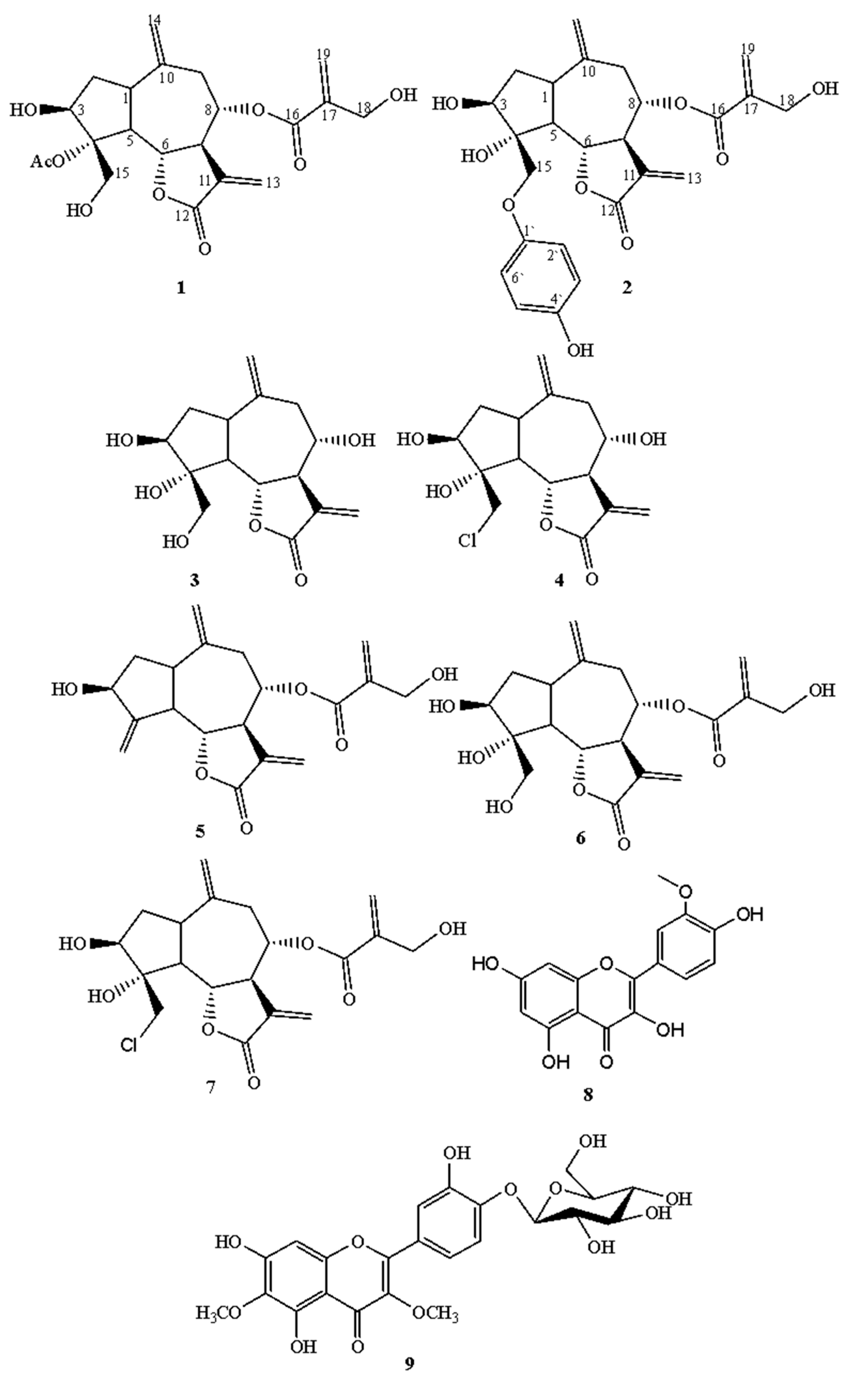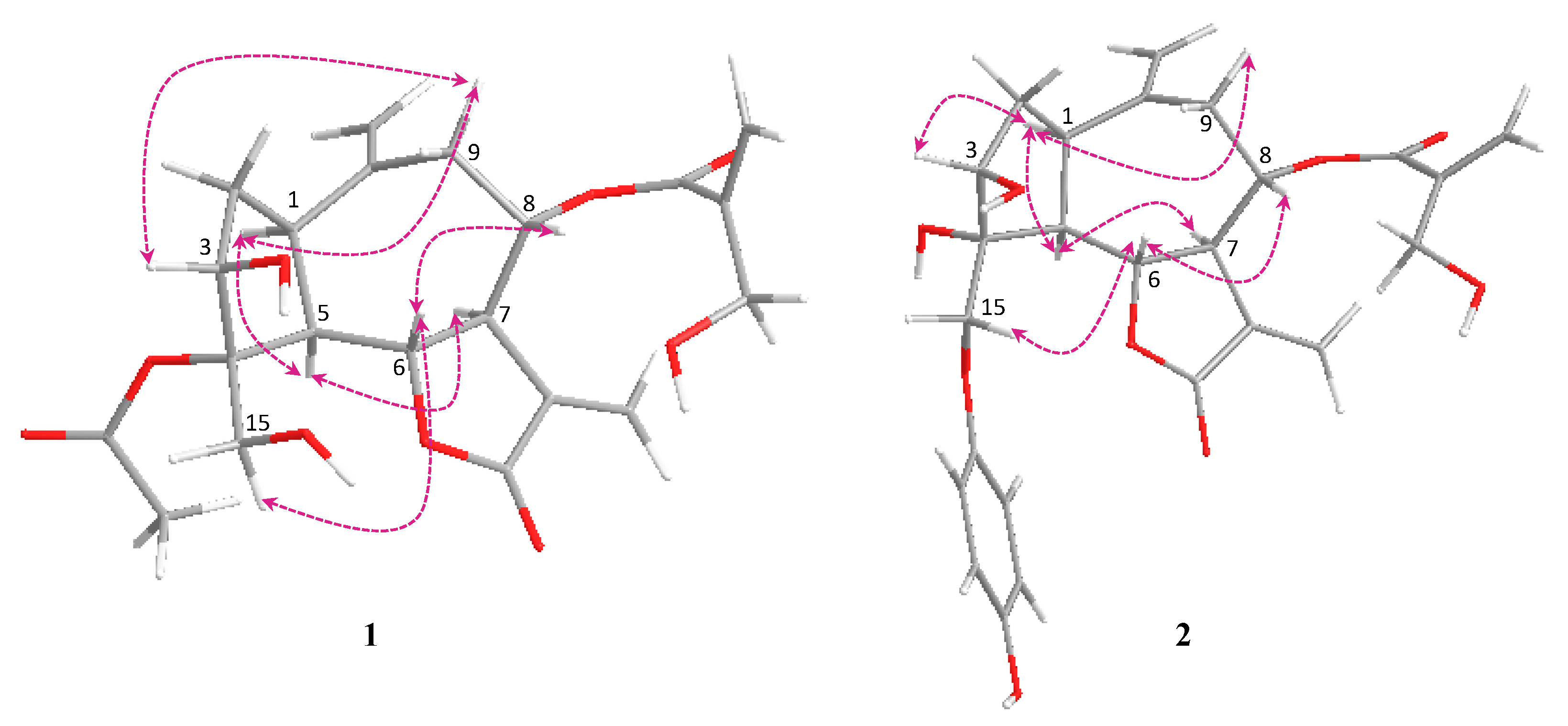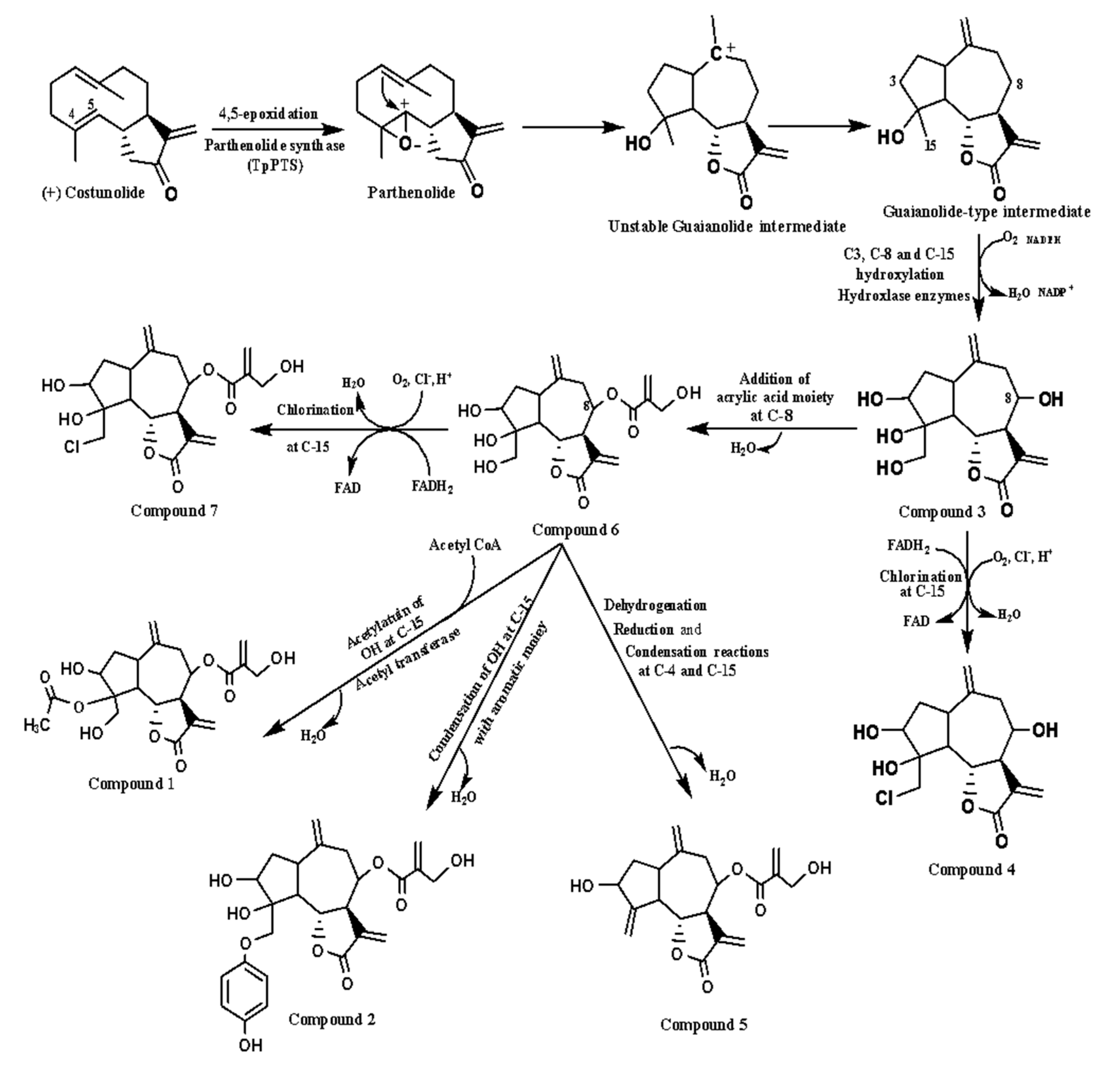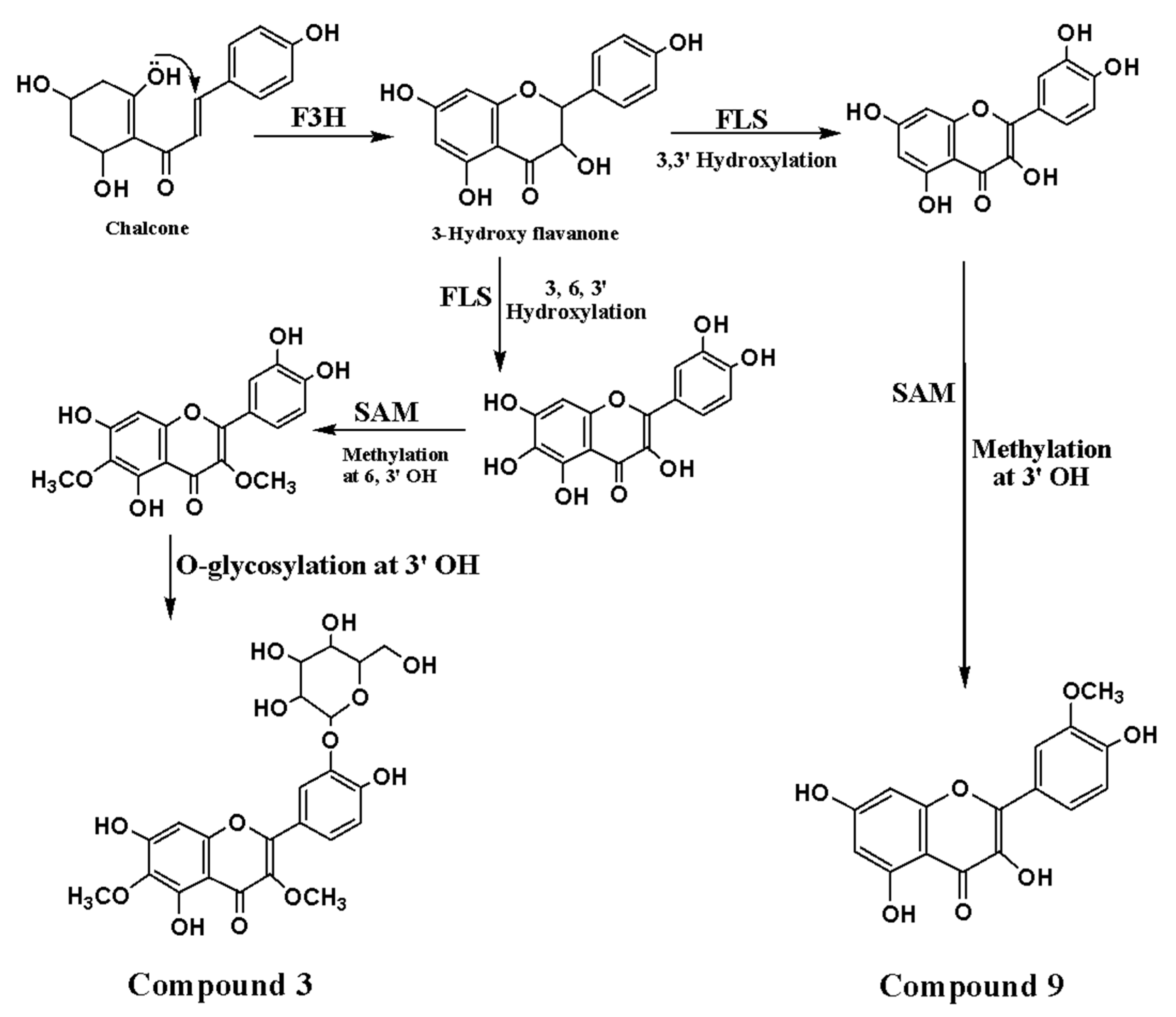Guaianolide Sesquiterpene Lactones from Centaurothamnus maximus
Abstract
1. Introduction
2. Results
2.1. Structure Elucidation of the Isolated Compounds
2.2. Proposed Biosynthetic Pathway of the Isolated Compounds
2.3. Chemosystematic Significance
3. Materials and Methods
3.1. General Procedures
3.2. Plant Material
3.3. Extraction and Isolation
4. Conclusions
Supplementary Materials
Author Contributions
Funding
Institutional Review Board Statement
Informed Consent Statement
Data Availability Statement
Conflicts of Interest
Sample Availability
References
- Collenette, S. Wild Flowers of Saudi Arabia; The National Commission for Wildlife Conversation and Development (NCWCD): Riyadh, Saudi Arabia, 1999. [Google Scholar]
- Ghazal, E.M.A.A. Taxonomic studies on the family asteraceae (Compositae) of Hajjah governorate, West of Yemen. J. Med. Plants Stud. 2019, 7, 90–100. [Google Scholar]
- Wood, J.R. A Handbook of the Yemen Flora; Royal Botanic Gardens, Kew: London, UK, 1997. [Google Scholar]
- Basahi, M.A.; Thomas, J.; Al-Turkiº, T.A.; Alfarhan, A.H.; Al-Atar, A.A.; Sivadasan, M. Current status and conservation efforts of cevt4. Uroth, 4 mvus maximus wagenitz. S. Ditt rich. Plant Arch. 2010, 10, 807–814. [Google Scholar]
- Oksuz, S.; Topcu, G. Guaianolides from Centaurea-Glastifolia. Phytochemistry 1994, 37, 487–490. [Google Scholar] [CrossRef]
- Youssef, D.; Frahm, A.W. Constituents of the Egyptian Centaurea scoparia; Part II. Guaianolides of the aerial parts. Planta Med. 1994, 60, 572–575. [Google Scholar] [CrossRef]
- Barrero, A.F.; Sanchez, J.F.; Rodrı’guez, I. Germacranolides from Centaurea melitensis. Phytochemistry 1989, 28, 1975–1976. [Google Scholar] [CrossRef]
- Wang, Y.H.M.; Cheng, C.H.K.; Costall, B.; Naylor, R.J.; Jenner, P.; Hostettmann, K. Neurotoxic Sesquiterpenoids from the Yellow Star Thistle Centaurea solstitialis L. (Asteraceae). Helv. Chim. Acta 1991, 74, 117–123. [Google Scholar] [CrossRef]
- Tortajada, A.; Picher, M.T.; Reventos, M.M.; Amigo, J.M. Structure and Stereochemistry of Melitensin, an Elemanolide from Centaurea-Aspera Var Stenophylla. Phytochemistry 1988, 27, 3549–3550. [Google Scholar] [CrossRef]
- Bensouici, C.; Kabouche, A.; Kabouche, Z.; Touzani, R.; Bruneau, C. Sesquiterpene lactones and flavonoids from Centaurea foucauldiana. Chem. Nat. Compd. 2012, 48, 510–511. [Google Scholar] [CrossRef]
- Bohlmann, F. Naturally Occurring Acetylenes. Acad. Press N. Y. 1973, 452–460. [Google Scholar]
- Stevens, K.L.; Wong, R.Y. Structure of chlororepdiolide, a new sesquiterpene lactone from Centaurea repens. J. Nat. Prod. 1986, 49, 833–837. [Google Scholar] [CrossRef]
- Muhammad, W.; Takamatsu, S.; Mossa, J.S.; El-Feraly, F.S.; Walker, L.A.; Clark, A.M. Cytotoxic sesquiterpene lactones from Centaurothamnus maximus and Vicoa pentanema. Phytother. Res. 2003, 17, 168–173. [Google Scholar] [CrossRef] [PubMed]
- Alam, P.; Al-Anezi, M.; Siddiqui, N.A.; Alajmi, M.F.; Al-Rehaily, A.J.; Haque, A.; Ali, M. Isolation and characterization of a new oxygenated homoditerpenoid from leaves of Centaurothamnus maximus with antimicrobial potential. Pak. J. Pharm. Sci. 2015, 28, 1091–1095. [Google Scholar] [PubMed]
- Siddiqui, N.A.; Al Anezi, M.A.; Alam, P.; Haque, A.; Basodan, O.A.; Ali, M.J. Isolation of New Aliphatic Ester 8’[alpha]-Hydroxy-n-decanyl n-docosanoate from the Leaves of Centaurothamnus maximus Wagentz and Dittri. Asian J. Chem. 2015, 27, 2651. [Google Scholar] [CrossRef]
- Khan, S.B.; Azhar-ul-Haq; Perveen, S.; Afza, N.; Malik, A.; Nawaz, S.A.; Shah, M.R.; Choudhary, M.I. Butyrylcholinesterase inhibitory guaianolides from Amberboa ramosa. Arch. Pharm. Res. 2005, 28, 172–176. [Google Scholar] [CrossRef]
- Rial, C.; Novaes, P.; Varela, R.M.; Molinillo, J.M.; Macias, F.A. Phytotoxicity of cardoon (Cynara cardunculus) allelochemicals on standard target species and weeds. J. Agric. Food Chem. 2014, 62, 6699–6706. [Google Scholar] [CrossRef] [PubMed]
- Iranshahy, M.; Tayarani-Najaran, Z.; Kasaian, J.; Ghandadi, M.; Emami, S.A.; Asili, J.; Chandran, J.N.; Schneider, B.; Iranshahi, M. Highly Oxygenated Sesquiterpene Lactones from Cousinia aitchisonii and their Cytotoxic Properties: Rhaserolide Induces Apoptosis in Human T Lymphocyte (Jurkat) Cells via the Activation of c-Jun n-terminal Kinase Phosphorylation. Phytother. Res. 2016, 30, 222–226. [Google Scholar] [CrossRef]
- Saklani, A.; Hegde, B.; Mishra, P.; Singh, R.; Mendon, M.; Chakrabarty, D.; Kamath, D.V.; Lobo, A.; Mishra, P.D.; Dagia, N.M.; et al. NF-κB dependent anti-inflammatory activity of chlorojanerin isolated from Saussurea heteromalla. Phytomed. Int. J. Phytother. Phytopharm. 2012, 19, 988–997. [Google Scholar] [CrossRef] [PubMed]
- Litvinenko, V.I.; Bubenchikova, V.N. Phytochemical Study of Centaurea-Cyanus. Khim. Prir. Soedin+ 1988, 24, 672–674. [Google Scholar] [CrossRef]
- Hua, Y.; Wang, H.Q. Studies on the flavonoids from whole herbs of Seriphidium terrae-albae. Zhongguo Zhong Yao Za Zhi 2006, 31, 820–822. [Google Scholar]
- Karamenderes, C.; Bedir, E.; Pawar, R.; Baykan, S.; Khan, K.A. Elemanolide sesquiterpenes and eudesmane sesquiterpene glycosides from Centaurea hierapolitana. Phytochemistry 2007, 68, 609–615. [Google Scholar] [CrossRef]
- Holub, M.; Budesinsky, M. On Terpenes 292. Sesquiterpene Lactones of the Umbelliferae. Phytochemistry 1986, 25, 2015–2026. [Google Scholar] [CrossRef]
- Azarken, R.; Guerra, F.M.; Moreno-Dorado, F.J.; Jorge, Z.D.; Massanet, G.M. Substituent effects in the transannular cyclizations of germacranes. Synthesis of 6-epi-costunolide and five natural steiractinolides. Tetrahedron 2008, 64, 10896–10905. [Google Scholar] [CrossRef]
- Stevens, K.L.; Witt, S.C.; Kint, S.; Haddon, W.F.; Benson, M. Picrolide-a—An Unusual Sesquiterpene Lactone from Acroptilon-Repens. J. Nat. Prod. 1991, 54, 276–280. [Google Scholar] [CrossRef]
- Gutensohn, M.N.D.; Dudareva, N. Involvement of compartmentalization in monoterpene and sesquiterpene biosynthesis in plants. In Isoprenoid Synthesis in Plants and Microorganisms; Bach, T.J., Rohmer, M., Eds.; Springer: New York, NY, USA, 2013; pp. 155–169. [Google Scholar]
- Lange, B.M.; Ahkami, A. Metabolic engineering of plant monoterpenes, sesquiterpenes and diterpenes-current status and future opportunities. Plant Biotechnol. J. 2013, 11, 169–196. [Google Scholar] [CrossRef]
- Bouwmeester, H.J.; Kodde, J.; Verstappen, F.W.; Altug, I.G.; de Kraker, J.W.; Wallaart, T.E. Isolation and characterization of two germacrene A synthase cDNA clones from chicory. Plant Physiol. 2002, 129, 134–144. [Google Scholar] [CrossRef]
- De Kraker, J.W.; Franssen, M.C.; Joerink, M.; de Groot, A.; Bouwmeester, H.J. Biosynthesis of costunolide, dihydrocostunolide, and leucodin. Demonstration of cytochrome p450-catalyzed formation of the lactone ring present in sesquiterpene lactones of chicory. Plant Physiol. 2002, 129, 257–268. [Google Scholar] [CrossRef]
- Ikezawa, N.; Gopfert, J.C.; Nguyen, D.T.; Kim, S.U.; O’Maille, P.E.; Spring, O.; Ro, D.K. Lettuce costunolide synthase (CYP71BL2) and its homolog (CYP71BL1) from sunflower catalyze distinct regio- and stereoselective hydroxylations in sesquiterpene lactone metabolism. J. Biol. Chem. 2011, 286, 21601–21611. [Google Scholar] [CrossRef]
- Liu, Q.; Majdi, M.; Cankar, K.; Goedbloed, M.; Charnikhova, T.; Verstappen, F.W.A.; de Vos, R.C.H.; Beekwilder, J.; van der Krol, S.; Bouwmeester, H.J. Reconstitution of the Costunolide Biosynthetic Pathway in Yeast and Nicotiana benthamiana. PLoS ONE 2011, 6. [Google Scholar] [CrossRef]
- Piet, D.P.; Schrijvers, R.; Franssen, M.C.R.; Degroot, A. Biotransformation of Germacrane Epoxides by Cichorium-Intybus. Tetrahedron 1995, 51, 6303–6314. [Google Scholar] [CrossRef]
- Dewick, P.M. The biosynthesis of C5-C20 terpenoid compounds. Nat. Prod. Rep. 1995, 12, 507–534. [Google Scholar] [CrossRef] [PubMed]
- Chang, M.C.; Keasling, J.D. Production of isoprenoid pharmaceuticals by engineered microbes. Nat. Chem. Biol. 2006, 2, 674–681. [Google Scholar] [CrossRef] [PubMed]
- Watson, R.R. Vegetables Fruits And Herbs In Health Promotion, 1st ed.; CRC Press: London, UK, 2001; Volume 7, pp. 140–141. [Google Scholar]
- Rangari, V.D. Pharmacognosy & Phytochemistry, 1st ed.; part-1; Carrier Publication: Nashik, India, 2008; Volume 171, p. 242. [Google Scholar]
- Cordell, G.A. Medicinal Natural Products: A Biosynthetic Approach; By PM Dewick (University of Nottingham); John Wiley and Sons, Ltd.: Oxford, UK; ACS Publications: Washington, DC, USA, 2002; Volume x1i 507, pp. 18–24. ISBN 0-471-49640-5. x1i+507 18.5× 24.5 cm. 115.00(72.95 paperback). [Google Scholar]
- Ferreres, F.; Tomas, F.; Guirado, A.; Tomas, F.A. Flavonoid aglycones in centaura-aspera (compositae). Afinidad 1980, 37, 337–338. [Google Scholar]
- Gadeschi, E.; Jorge, Z.; Massanet, G.; Luis, F.J.P. Two derivatives of costic acid from Centaurea arguta. Phytochemistry 1989, 28, 2204–2206. [Google Scholar] [CrossRef]
- Saroglou, V.; Karioti, A.; Demetzos, C.; Dimas, K.; Skaltsa, H. Sesquiterpene lactones from Centaurea spinosa and their antibacterial and cytotoxic activities. J. Nat. Prod. 2005, 68, 1404–1407. [Google Scholar] [CrossRef]
- Shakeri, A.; Amini, E.; Asili, J.; Masullo, M.; Piacente, S.; Iranshahi, M. Screening of several biological activities induced by different sesquiterpene lactones isolated from Centaurea behen L. and Rhaponticum repens (L.) Hidalgo. Nat. Prod. Res. 2018, 32, 1436–1440. [Google Scholar] [CrossRef]
- Al Easa, H.S.; Rizk, A.M. Constituents of Centaurea species. Phytochemistry 1992, 12, 27–57. [Google Scholar]
- Ayad, R.; Akkal, S. Phytochemistry and biological activities of algerian Centaurea and related genera. In Studies in Natural Products Chemistry; Elsevier: Amsterdam, The Netherlands, 2019; Volume 63, pp. 357–414. [Google Scholar]
- Lopez-Rodriguez, M.; Garcia, V.P.; Zater, H.; Benayache, S.; Benayache, F. Cynaratriol, a sesquiterpene lactone from Centaurea musimomum. Acta Cryst. E 2009, 65, o1867–o1868. [Google Scholar] [CrossRef]
- Ozcelik, B.; Gurbuz, I.; Karaoglu, T.; Yesilada, E. Antiviral and antimicrobial activities of three sesquiterpene lactones from Centaurea solstitialis L. ssp solstitialis. Microbiol. Res. 2009, 164, 545–552. [Google Scholar] [CrossRef] [PubMed]
- Nowak, G.D.-P.R.; Urbanska, M.; Nawrot, J. TLC of selected sesquiterpenoids of the Asteraceae family. Acta Soc. Bot. Pol. 2011, 80, 193–196. [Google Scholar] [CrossRef][Green Version]
- Demir, S.; Karaalp, C.; Bedir, E. Specialized metabolites from the aerial parts of Centaurea polyclada DC. Phytochemistry 2017, 143, 12–18. [Google Scholar] [CrossRef]
- Eldahmy, S.; Bohlmann, F.; Sarg, T.M.; Ateya, A.; Farrag, N. New Guaianolides from Centaurea aegyptica. Planta Med. 1985, 51, 176–177. [Google Scholar]
- Nowak, G.; Drożdż, B.; Kroszczyński, W.; Holub, M. Sesquiterpene lactones. XXX. Cynaropicrin in species of the subtribe Centaureanae Dumort. Acta Soc. Bot. Pol. 1986, 55, 17–22. [Google Scholar] [CrossRef]
- González, A.G.; Bermejo, J.; Amaro, J.M.; Massanet, G.M.; Galindo, A.; Cabrera, I. Sesquiterpene lactones from Centaurea linifolia Vahl. Can. J. Chem. 1978, 56, 491–494. [Google Scholar] [CrossRef]
- Gonzalez, A.G.; Bermejo, J.; Breton, J.L.; Massanet, G.M.; Triana, J. Chlorohyssopifolin C, D, E and vahlenin, four new sesquiterpene lactones from Centaurea hyssopifolia. Phytochemistry 1974, 13, 1193–1197. [Google Scholar] [CrossRef]
- Gonzalez, A.G.; Bermejo, J.; Breton, J.L.; Massanet, G.M.; Dominguez, B.; Amaro, J.M. The chemistry of the compositae. Part XXXI. Absolute configuration of the sesquiterpene lactones centaurepensin (chlorohyssopifolin A), acroptilin (chlorohyssopifolin C), and repin. J. Chem. Soc. Perkin Trans. 1 1976, 15, 1663–1666. [Google Scholar] [CrossRef]
- Gonzalez, A.G.; Bermejo, J.; Massanet, G.M. Aportacion al estudio quimiotaxonomico del genero Centaurea. Rev. Lat. Quim 1977, 8, 176–181. [Google Scholar]
- Sarg, T.; el-Dahmy, S.; el-Domiaty, M.; Ateya, A. Guaianolides and other constituents from Centaurea sinaica. Acta Pharm. Hung. 1988, 58, 129–133. [Google Scholar] [PubMed]
- Stevens, K.L. Sesquiterpene lactones from Centaurea repens. Phytochemistry 1982, 21, 1093–1098. [Google Scholar] [CrossRef]
- Stevens, K.L.M.G. The Chemistry of Alieopathy. 1984, 84–98. [Google Scholar]
- Bentamène, A.; Benayache, S.; Crèche, J.; Petit, G.; Bermejo-Barrera, J.; Leon, F.; Benayache, F. New guaianolide and other sesquiterpene lactones from Centaurea acaulis L.(Asteraceae). Biochem. Syst. Ecol. 2005, 33, 1061–1065. [Google Scholar] [CrossRef]
- Xu, C.C.; Wang, B.; Pu, Y.Q.; Tao, J.S.; Zhang, T. Advances in extraction and analysis of phenolic compounds from plant materials. Chin. J. Nat. Med. 2017, 15, 721–731. [Google Scholar] [CrossRef]
- Louaar, S.; Achouri, A.; Lefahal, M.; Laouer, H.; Medjroubi, K.; Duddeck, H.; Akkal, S. Flavonoids from Algerian Endemic Centaurea microcarpa and their Chemotaxonomical Significance. Nat. Prod. Commun. 2011, 6, 1603–1604. [Google Scholar] [CrossRef]
- Hammoud, L.; Seghiri, R.; Benayache, S.; Mosset, P.; Lobstein, A.; Chaabi, M.; Leon, F.; Brouard, I.; Bermejo, J.; Benayache, F. A new flavonoid and other constituents from Centaurea nicaeensis All. var. walliana M. Nat. Prod. Res. 2012, 26, 203–208. [Google Scholar] [CrossRef]
- Bouzghaia, B.; Moussa, M.T.B.; Goudjil, R.; Harkat, H.; Pale, P. Chemical composition, in vitro antioxidant and antibacterial activities of Centaurea resupinata subsp. dufourii (dostal) greuter. Nat. Prod. Res. 2020, 1–6. [Google Scholar] [CrossRef] [PubMed]
- Grienke, U.; Radic Brkanac, S.; Vujcic, V.; Urban, E.; Ivankovic, S.; Stojkovic, R.; Rollinger, J.M.; Kralj, J.; Brozovic, A.; Radic Stojkovic, M. Biological Activity of Flavonoids and Rare Sesquiterpene Lactones Isolated From Centaurea ragusina L. Front. Pharm. 2018, 9, 972. [Google Scholar] [CrossRef]
- González, A.G.; Arteaga, J.M.; Bretón, J.L. Germacranolides from Centaurea seridis. Phytochemistry 1973, 12, 2997–2999. [Google Scholar] [CrossRef]
- Nowak, G.; Holub, M.; Buděšĺnský, M. Sesquiterpene lactones. XXXVI. Sesquiterpene lactones in several subgenera of the genus Centaurea, L. Acta Soc. Bot. Pol. 1989, 58, 95–102. [Google Scholar] [CrossRef]
- Oksuz, S.; Putun, E. Flavonoids of Centaurea kotschyi var Kotschyi. Doga Turk Kim. Derg 1987, 11, 66–71. [Google Scholar]
- Bakr, R.O.; Mohamed, S.; Ayoub, N. Phenolic profile of Centaurea aegyptiaca l. growing in egypt and its cytotoxic and antiviral activities. Afr. J. Tradit. Complementary Altern. Med. Ajtcam 2016, 13, 135–143. [Google Scholar] [CrossRef] [PubMed]





| No. | 1 | 2 | 3 | 4 | 5 | 6 | 7 | ||
|---|---|---|---|---|---|---|---|---|---|
| δH | δC | δH | δC | δC | δC | δC | δC | δC | |
| 1 | 3.52 m * | 46.4 | 3.60 m * | 46.3 | 43.4 | 47.1 | 44.8 | 44.5 | 46.1 |
| 2 | 1.60 m *, 2.35 m * | 38.3 | 1.60 m * | 39.8 | 43.3 | 38.6 | 38.6 | 37.6 | 38.6 |
| 3 | 4.05 dd (7.5, 5.7) | 76.1 | 4.16 m * | 76.1 | 77.5 | 75.6 | 72.8 | 77.0 | 75.6 |
| 4 | - | 83.4 | - | 83.8 | 83.1 | 84.4 | 152.6 | 83.9 | 84.5 |
| 5 | 2.36 t (9.9) | 57.1 | 2.45 dd (17.2, 6.5) | 57.3 | 55.1 | 58.4 | 50.7 | 55.6 | 58.3 |
| 6 | 4.84 t (12.9) | 77.1 | 4.90 (21.5) | 77.2 | 77.8 | 77.5 | 78.9 | 77.4 | 77.1 |
| 7 | 3.22 brt (9.3) | 48.2 | 3.35 m* | 47.3 | 51.2 | 49.2 | 48.2 | 47.4 | 47.8 |
| 8 | 5.15 ddd (10.5, 4.2, 2.0) | 74.2 | 5.16 m | 74.2 | 71.9 | 71.1 | 74.3 | 74.4 | 74.1 |
| 9 | 2.75 dd (13.5, 5.9), 2.42 m | 35.0 | 2.76 dd (7.5, 6.9), 2.39 dd (12.9,10.7) | 38.4 | 36.5 | 38.6 | 36.3 | 37.0 | 34.4 |
| 10 | - | 143.0 | - | 143.5 | 142.8 | 143.8 | 142.6 | 142.1 | 143.6 |
| 11 | - | 138.0 | - | 140.6 | 137.3 | 139.0 | 138.3 | 136.8 | 138.0 |
| 12 | - | 169.5 | - | 165.2 | 170.2 | 170.2 | 169.9 | 169.9 | 169.5 |
| 13 | 6.10 d (3.8), 5.60 d (3.24) | 120.8 | 5.66 d (4.1), 6.12 d (4.1) | 121.5 | 124.1 | 121.2 | 121.1 | 123.3 | 120.8 |
| 14 | 5.14 brs, 4.82 brs | 116.5 | 5.1 brs, 4.75 brs | 117.0 | 116.1 | 115.5 | 116.8 | 117.4 | 116.1 |
| 15 | 4.50 d (12.0) | 66.5 | 4.59 d (13.9) | 66.2 | 63.6 | 48.7 | 111.5 | 63.4 | 48.7 |
| 16 | - | 165.2 | 3.4 brs, 2.41 brs | 169.5 | 165.17 | 165.5 | 165.2 | ||
| 17 | - | 140.6 | 5.99 d (3.6), 6.33 d (3.6) | 138.1 | - | - | 140.5 | 139.7 | 140.6 |
| 18 | 4.33 brs | 60.2 | 4.33 s | 60.2 | - | - | 60.3 | 61.4 | 60.2 |
| 19 | 6.32 brs, 5.99 brs | 124.5 | - | 124.5 | - | - | 124.6 | 126.3 | 124.5 |
| 1′ | - | - | 138.1 | - | - | - | - | - | |
| 2′ | - | 6.85 d (10.5) | 114.6 | - | - | - | - | - | |
| 3′ | - | 8.00 d (10.5) | 131.7 | - | - | - | - | - | |
| 4′ | - | - | 124.5 | - | - | - | - | - | |
| 5′ | - | 8.00 d (10.5) | 131.7 | - | - | - | - | - | |
| 6′ | - | 6.85 d (10.5) | 114.6 | - | - | - | - | - | |
| C=O, OAc | - | 171.9 | - | - | - | - | - | - | - |
| CH3, OAc | 2.11 s | 19.5 | - | - | - | - | - | - | - |
Publisher’s Note: MDPI stays neutral with regard to jurisdictional claims in published maps and institutional affiliations. |
© 2021 by the authors. Licensee MDPI, Basel, Switzerland. This article is an open access article distributed under the terms and conditions of the Creative Commons Attribution (CC BY) license (https://creativecommons.org/licenses/by/4.0/).
Share and Cite
Hussien, T.A.; Mohamed, T.A.; Elshamy, A.I.; Moustafa, M.F.; El-Seedi, H.R.; Pare, P.W.; Hegazy, M.-E.F. Guaianolide Sesquiterpene Lactones from Centaurothamnus maximus. Molecules 2021, 26, 2055. https://doi.org/10.3390/molecules26072055
Hussien TA, Mohamed TA, Elshamy AI, Moustafa MF, El-Seedi HR, Pare PW, Hegazy M-EF. Guaianolide Sesquiterpene Lactones from Centaurothamnus maximus. Molecules. 2021; 26(7):2055. https://doi.org/10.3390/molecules26072055
Chicago/Turabian StyleHussien, Taha A., Tarik A. Mohamed, Abdelsamed I. Elshamy, Mahmoud F. Moustafa, Hesham R. El-Seedi, Paul W. Pare, and Mohamed-Elamir F. Hegazy. 2021. "Guaianolide Sesquiterpene Lactones from Centaurothamnus maximus" Molecules 26, no. 7: 2055. https://doi.org/10.3390/molecules26072055
APA StyleHussien, T. A., Mohamed, T. A., Elshamy, A. I., Moustafa, M. F., El-Seedi, H. R., Pare, P. W., & Hegazy, M.-E. F. (2021). Guaianolide Sesquiterpene Lactones from Centaurothamnus maximus. Molecules, 26(7), 2055. https://doi.org/10.3390/molecules26072055











